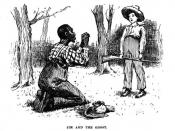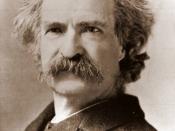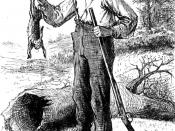�PAGE � �PAGE �1�
Adventures of Huckleberry Finn and Slavery Narrative Analysis
Mark Twain had direct experience with the slavery that he described in Adventures of Huckleberry Finn. When Mark Twain in 1884 / 1885 wrote his Adventures of Huckleberry Finn, describing a series of Mississippi river-town adventures experienced by a white boy, he created his novel in slavery time Missouri. During his writing, many influences prompted the author to examine the contemporary conditions of the black (Champion 54). From the novel the reader gathers a deep understanding of the meaning of living in a slave society in the period when slave trade was brisk.
The person who reads Adventures of Huckleberry Finn does not come upon the discussion of slavery until Chapter Two, when Mark Twain describes how Huck and Tom spend their lives in a slaveholding society. The opening chapters contain what can be described as Tom Sawyer's total experiences that make up his life.
In these chapters the reader is led to see these circumstances and society as Tom Sawyer does. As a result, the slave Jim is illustrated mainly as a character to laugh at and play jokes and tricks on, and slavery is introduced as a normal and logical phenomenon. From this perspective, Jim is naive and disposed to believe in superstition - a humorous story character rather than a human being with ability to feel deeply and have thoughts and ideas.
As Huck and Jim go beyond the social world of Tom Sawyer and have a good time alone together on the bank of the river, Jim begins to cast off the comic characteristics. It is as if Mark Twain begins portraying Jim through Huck's observation rather than Tom's observation. As Huck increasingly considers Jim as a more and more complex person with ideas...


